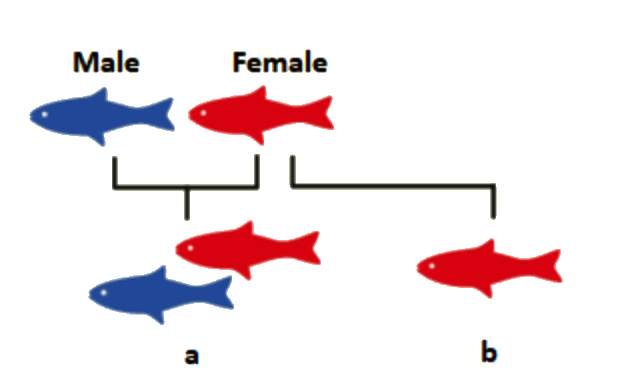Which corresponds to parthenogenesis ?
(a) Autogamy
(b) Endomixis
(c) Cytogamy
(d) Amphimixis
Autogamy
Endomixis
Cytogamy
Amphimixis
The correct Answer is:B
To determine which option corresponds to parthenogenesis, we need to analyze each of the given terms:
1. Understanding Parthenogenesis:
- Parthenogenesis is a form of asexual reproduction where an embryo develops from an unfertilized egg. This means that the offspring are produced without the fusion of gametes, resulting in a clone of the parent.
2. Analyzing Each Option:
- (a) Autogamy: This refers to the production of gametes by the division of a single parent cell. Since parthenogenesis does not involve the production of gametes but rather the development of an embryo from an unfertilized egg, this option does not correspond to parthenogenesis.
- (b) Endomixis: This involves nuclear reorganization within a single cell. While it does not directly correspond to parthenogenesis, it is the closest option since it involves processes within one cell. However, it is not a direct match as parthenogenesis specifically refers to the development of an embryo from an unfertilized egg.
- (c) Cytogamy: This is the joining of two parent cells without nuclear exchange. Since parthenogenesis involves only one parent, this option is incorrect.
- (d) Amphimixis: This refers to the fusion of two gametes to form a zygote. Since parthenogenesis does not involve the fusion of gametes, this option is also incorrect.
3. Conclusion:
- After analyzing all options, we find that (b) Endomixis is the most relevant to parthenogenesis, as it involves processes within a single cell, even though it is not a perfect match. The other options either involve two parents or the production of gametes, which do not align with the definition of parthenogenesis.
Thus, the correct answer is (b) Endomixis.
- Parthenogenesis is a form of asexual reproduction where an embryo develops from an unfertilized egg. This means that the offspring are produced without the fusion of gametes, resulting in a clone of the parent.
- (a) Autogamy: This refers to the production of gametes by the division of a single parent cell. Since parthenogenesis does not involve the production of gametes but rather the development of an embryo from an unfertilized egg, this option does not correspond to parthenogenesis.
- (b) Endomixis: This involves nuclear reorganization within a single cell. While it does not directly correspond to parthenogenesis, it is the closest option since it involves processes within one cell. However, it is not a direct match as parthenogenesis specifically refers to the development of an embryo from an unfertilized egg.
- (c) Cytogamy: This is the joining of two parent cells without nuclear exchange. Since parthenogenesis involves only one parent, this option is incorrect.
- (d) Amphimixis: This refers to the fusion of two gametes to form a zygote. Since parthenogenesis does not involve the fusion of gametes, this option is also incorrect.
- After analyzing all options, we find that (b) Endomixis is the most relevant to parthenogenesis, as it involves processes within a single cell, even though it is not a perfect match. The other options either involve two parents or the production of gametes, which do not align with the definition of parthenogenesis.
Topper's Solved these Questions
Similar Questions
Pollination between flower of different plant of the same specise is
(a) Xenogamy
(b) Geitonogamy
(c) Autogamy
(d) Homogamy
View SolutionThe only type of pollination which during pollination brings genetically different types of pollen grains to the stigma, is:
(a) Xenogamy
(b) Geitonogamy
(c) Chasmogamy
(d) Autogamy
View Solution
Knowledge Check
Select correct answers from the choices A, B, C, D which are given. Write down only the letter corresponding to the correct answer.
Which of the following oxides reacts with an acid as well as a base? A ZnO, B CuO, C FeO, D CaOAZnOBCuOCFeODCaO
Which is a character of Castor plant to avoid autogamy?
(a) Unisexuality
(b) Porogamy
(c) Protandry
(d) Heterostyly
View SolutionWhich of the following does ensure autogamy in viola?
(a) Cleistogamy
(b) Homogamy
(c) Bud pollination
(d) Dichogamy
View SolutionThe ability of starfishes to break-off their arms is an example of
(a) Autogamy
(b) Neoteny
(c) Autophagy
(d) Autotomy
View SolutionObserve the diagram given below and identify a and b.

(1) a: Amphimixis , b : Parthenocarpy
(2) a: Amphimixis , b : Parthenogenesis
(3) a: Parthenocarpy ,b : Amphimixis
(4) a: Parthenogenesis , b: sexual reproduction
View SolutionAsexual reproduction in sponges occurs by
(a) Parthenogenesis
(b) Budding
(c) Fragmentation
(d) Spore
View SolutionIdentify the correct sequence of events with refernce to conjugation of Vorticella
(a) Amphimixis
(b) Disappearance of macronucleus
(c ) Attachment of the conjugants
(d) Post conjugation fissions
(e) Prezygotic nuclear divisions
(f) Postzygotic nuclear divisions.
View SolutionIn Castor and Maize plants
(a) Autogamy is prevented but not geitonogamy
(b) Both autogamy and geitonogamy are prevented
(c) Male and female flowers are borne by different plants
(d) Anthers and stigma are placed at different positions to encourage cross pollination
View Solution
